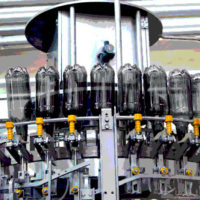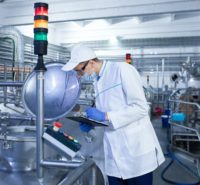Polystyrene Foam Trays Set the Standard for Food Safety and Quality Assurance

There was a time when proteins were packaged in cardboard paper-pulp cartons that were flimsy and leaked. Purge from proteins like steak, chicken and fish would drip from inside the packaging and create a trail from the grocery shelf all the way to the consumer’s kitchen.
“Remember the old pulp paper egg cartons? This material was used for all kinds of food, and the purge from the protein would be absorbed into the pulp paper. The container would get soft and just not hold up,” says Grant Moyer, a technical marketing manager with Novipax, Oak Brook, IL, a company that has produced polystyrene trays for use in food packaging for more than five decades. “There was a great need for something that could stand up to the moisture, particularly the purge from food like fresh red meat, poultry and pork.”
In the late 1970s, the industry standard became polystyrene foam trays, which protect the food from leakage and bacteria as it moves along the production and supply chain from the processor to the consumer, while also offering a more appealing packaging. The polystyrene foam also helps the food last longer amid a climate of increasingly strict industry standards for food safety.
“The change was driven by the processors and the retailers in terms of merchandising the product,” Moyer adds. “They didn’t want packaging that was soaking wet or soggy. The consumer also pushed for a more practical package so when they got home they didn’t have a mess on their hands. Foam fit the bill.”
Rigorous Food Safety Demands
When packaging comes in direct contact with food, the materials must meet strict safety regulations. Most major North American retailers now require certification from the Safe Quality Foods Program (SQF).
SQF requires certification through a rigorous, credible food safety management system. The “Farm to Fork Safety” program was launched in Australia in 1994. Since 2004, it has been administered by the SQF Institute, a division of the Food Marketing Institute, headquartered in Arlington, VA.
SQF certification provides assurance that a product, process or service complies with regulatory, international and scientifically proven standards for safety.
The Global Food Safety Initiative (GFSI) is a collaboration of the world’s leading food safety experts, representing a broad range of participants in the supply chain, from primary producer to retailer. Launched in May 2000, this international initiative engaged in a benchmarking process to establish the key components necessary for good food safety standards, and the operating protocols for the delivery of third-party certification.
Moyer recommends that retailers and distributors ask for a U.S. Department of Agriculture letter of guarantee from the tray supplier and insist that the packaging is Level II GFSI- and SQF-compliant.
“These requirements are a very stringent and demanding set of food defense and food safety requirements that are strict but necessary, and they are driven by not only people like us who provide packaging, but also by the food processors,” Moyer says. “We want the end-user to be confident that their food has been packaged in a clean, safe product. The polystyrene foam trays also have thermal benefits and can keep food cooler or warmer, particularly for the end user, going from the grocery story to the consumer’s home.”
Benefits of Polystyrene Foam Trays
In addition to being food safety compliant, polystyrene foam trays are a more sanitary form of food packaging because they are disposable. They are also shatter-resistant, even in extreme temperatures.
Some processors have a blast-freeze operation that exposes trays to 28 ºF (-2 ºC) for more than an hour. Solid materials may not survive these extreme conditions as well and can become brittle. Foam is a stable environment for a wide range of temperatures.
“Foam trays have been the industry standard for decades because they are very effective at what they do, and they are very economical,” Moyer notes. “There have been other formats through the years, especially with a movement toward green products, but foam remains the flagship of the industry, particularly with retail supermarkets and processors.”
Foam trays also have economic advantages. According to Moyer, “Foam is a low-density material. There is a lot of air in the product, so we can reduce the amount of material we use. This is called source reduction, and it means there is less material to recycle and go into the landfill. This keeps costs down, especially when compared with a solid materials.”
Moyer says that Novipax ships its trays in in two layers of polyethylene film—an inner sleeve and an outer bag—to help protect against dust and debris during storage and handling.
In addition to these benefits, the rigid format of polystyrene trays also lends to a more appealing format for merchandising because they can be stacked or shingled in an organized and uniform manner in the display case.
“This makes these trays literally the ‘backbone’ for most meat-protein packaging,” says Scott Maurer, director of marketing and product development for Novipax. “You can fit more of them onto a display case unlike, for example, chicken nuggets that are loose inside a bag.”
Polystyrene foam is also recyclable, and many municipalities are working on initiatives to provide more availability for recycling this type of material.
Trays for Various Applications
Different trays meet the needs for various applications:
- Supermarket Meat and Produce Trays are lighter weight and sold through a distribution network to supermarkets for use with some meat and produce-packaging applications. For example, some stores use these trays for ground beef, asparagus spears, cucumbers and even corn on the cob.
- Processor Trays have a heavier weight. These trays are overwrapped with film and used by major poultry, fresh red meat, pork, lamb and veal processors who then sell directly to the supermarkets. The heavier weight provides a more robust product, better able to withstand the rigors of the automated high-speed packaging operations of most processors.
- Barrier Foam Trays are modified atmosphere packages that are sold to processors and shipped in cardboard pallets. Trays are made with materials that provide an exceptionally high oxygen barrier that allows the tray to be hermetically sealed with barrier lid stock and then gas-flushed to provide a secure, airtight, modified-atmosphere package for a variety of meat, fish, poultry and cheese products. They offer a longer shelf life and preserve freshness, but are also more expensive.
- Not as commonly used, but popular on the West Coast, are Polylactic Acid Trays, a biodegradable material derived from renewable resources, such as corn. They will decompose in a compost heap. However, they are more expensive to produce and softer than polystyrene foam.
The Manufacturing Process
Moyer adds that his company uses a manufacturing system that is virtually 100% closed-looped, which means that there is very little scrap or waste.
“We recycle and reuse as much material as possible,” he says. “The foam is extruded and then thermoformed and any excess material that is generated after the trays are trimmed is recycled and reused. Using this recycled material helps to keep our costs down because it minimizes the use of prime resin.”
It is also important to have stringent quality parameters within the manufacturing process, particularly when producing products that have contact with food.
“Every department in our factories has standard operating procedures with numerous operating conditions held to very tight ranges and strict food safety and food defense standards,” Moyer states. “Every operation—extrusion, thermoforming, coating/lamination and even the recycling department—has food safety standards that we adhere to.”
Conclusion
It’s important for any product that comes into contact with food to have systems to keep it clean and free of bacteria.
“While we process foam at extremely high temperatures that would kill off any bacteria, our equipment and product surfaces are periodically monitored for bacteria as well,” Moyer says. “We also take the extra step of double-packaging, as an added precaution, to help prevent contamination during storage and shipping. When the user gets our product, they can be sure every precaution has been taken to provide a clean, safe product. Even the trailers in which we ship our products are monitored to prevent exposure to dirt, dust and debris.”
Moyer adds that history supports his claim that polystyrene foam gets the job done effectively, economically and safely.
“Foam has been used in food applications for decades,” he says. “It’s the industry standard for most fresh red meat, poultry, veal, lamb, supermarket vegetables and produce. It has been proven to be a safe, effective package configuration, and it holds up well to the processor, to the supermarket and to the consumer when they take it home. It is regulated by the U.S. Food and Drug Administration, with stringent manufacturing quality and hygienic requirements. As a bonus, it’s easy for processors to load their food into the tray, appealing for supermarket marketers and safe for the consumer.”
John Calvert is the manager for Sales & Product Applications for Novipax. He has been in the food packaging industry for 25 years and earned a Bachelor’s and Master’s of Science in Food Chemistry from the University of Kentucky. He can be reached at John.Calvert@novipax.com.
Looking for a reprint of this article?
From high-res PDFs to custom plaques, order your copy today!





